For plenty of folks in the northern parts of the globe, when the leaves start to fall, the winter tires and wheels go on—and then as the birds begin to chirp in the spring, the summer rollers return. That seasonal tire swap routine can be downright essential to navigating snow- and ice-covered roads.
We wrote an entire article on the benefits of winter tires a while back, but if you’ve already made the jump to a dedicated set of seasonal tires, we figured this companion article would help.
That’s because you’re now faced with the conundrum of what to do with those unused wheels/tires in their respective offseasons. And improper storage can not only shorten the lifespan of your tires, they can make them unsafe to drive on—which kind of defeats the whole purpose of the snow tire thing to begin with.
Check out our five tips below, and if you have any of your own, we’d love to hear them. Please add your suggestions to the comments section at the bottom of this article.
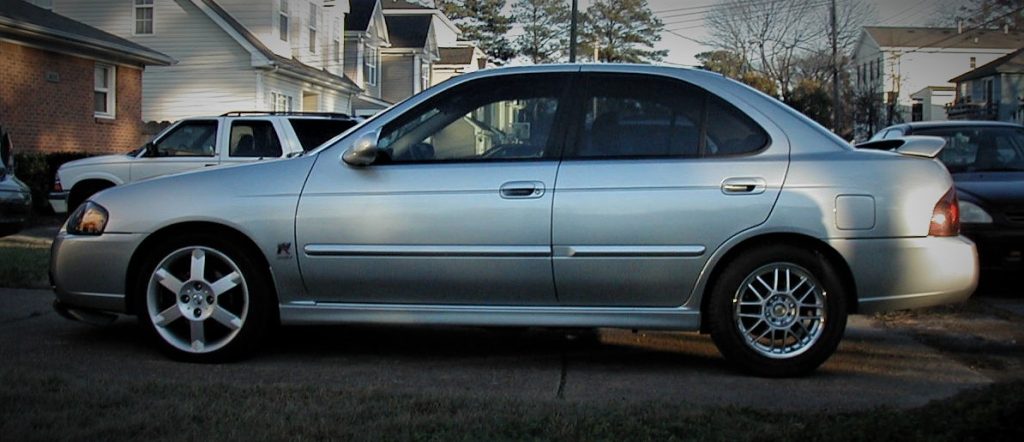
***
5 Seasonal Winter/Summer Tire Storage Tips
***
1. Check for Proper Inflation (PSI) Before & After Install/Storage
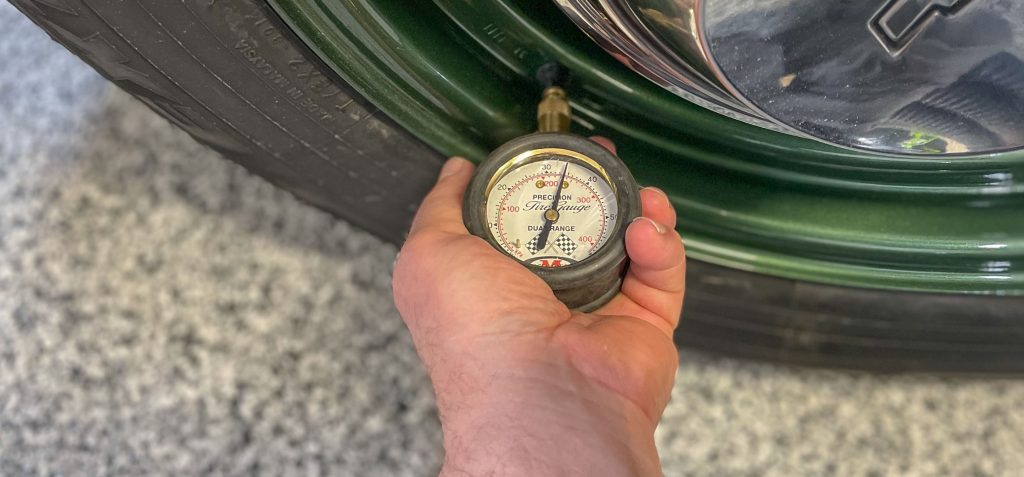
Look, this one was so obvious we debated even including it on the list—but since it’s also the most important facet of tire safety, it’d be a serious oversight not to put it at number one here. So yeah, check your tire pressure often.
Not only should you check the PSI on the tires that are going onto your vehicle, make sure you check the pressure on the tires going into storage. According to our pals at Goodyear, you should keep the PSI of the tires going into storage consistent with what the vehicle’s manufacturer recommends:
“Maintain Recommended Air Pressure. If your tires are left on the wheels for storage, maintain the vehicle manufacturer recommended air pressure.”
By checking your tires before and after they go into static storage, you’ll be able to monitor for potential leaks too. It might also be a good idea to check your stored tires every month or so, because if you do spot a leak, it’s a lot easier to drop off the offending tire for a repair during its downtime. Make sense?
If you’re not sure how to check you tire pressure, read this: Quick Tips for Checking Tire Pressure
***
2. Clean Your Wheels & Tires Prior to Storage
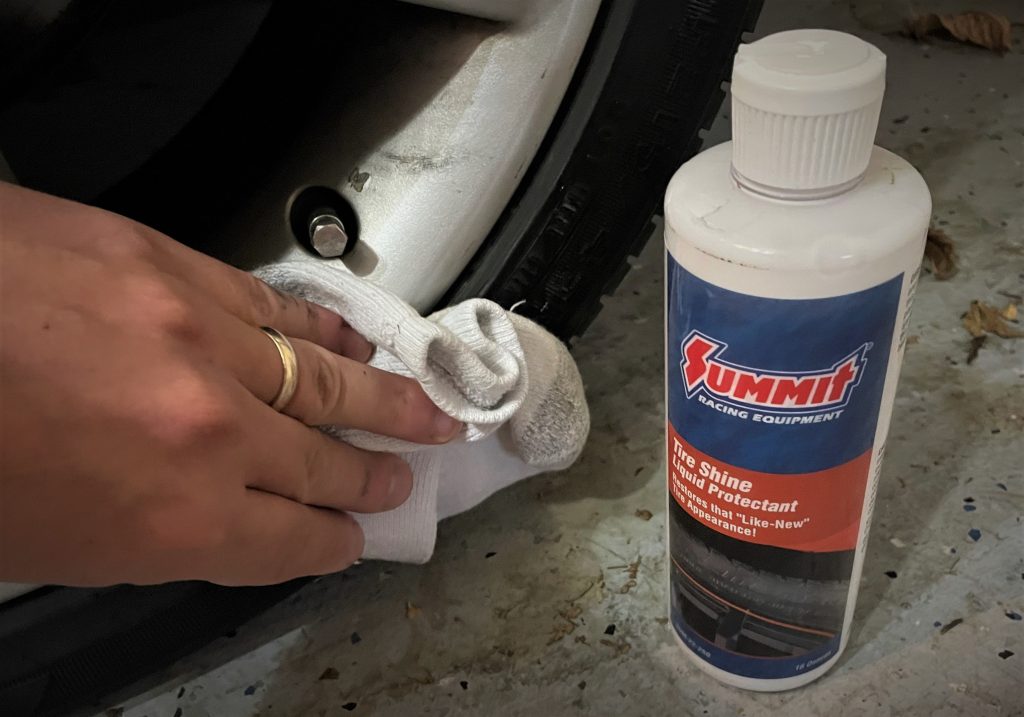
This may be another no-brainer, but a nonetheless vital one: Clean your tires and wheels before they go into seasonal storage.
This step serves two main purposes.
For starters, it removes the grit, grime, and contaminants that may eat away at your tires as they slumber. This is particularly important on winter tires, as they’ve likely endured miles of snow- and salt-strewn roads that can wreak havoc on the tire and wheel. As an added bonus, some tire cleaning products have UV blockers and other protectants to keep your rubber shielded during the offseason.
But Goodyear offers some smart advice on cleaning products too:
“Stay away from using any cleaning products that are petroleum-based, as the products may degrade the rubber’s weathering agents that may lead to premature cracking.”
Secondly, cleaning your tires helps you check for damage and unusual wear patterns. Make sure to notice anything awry prior to storage because, just like our note on inflation in point one, it means you have a chance to repair or resolve the issue while the other seasonal tires are on the vehicle.
And don’t just worry about the tires—give your wheels a thorough cleaning too. Since you’ll have unrestricted access to all the nooks-and-crannies behind the rim, a good cleaning can go a long way towards preventing gunky buildup that can permanently mar the wheel’s finish.
***
3. Note the Install/Removal Order
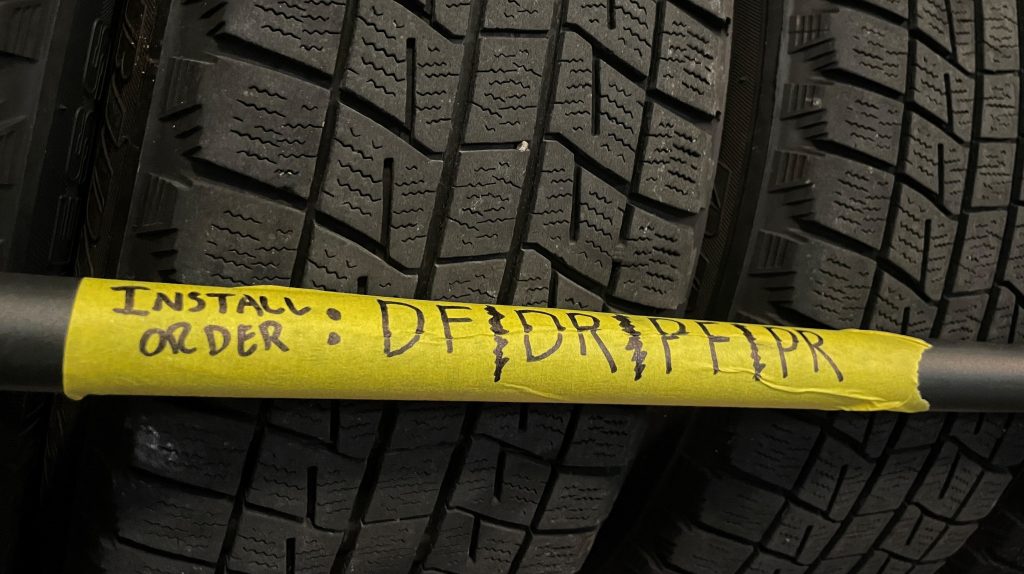
Don’t just yank your wheels off willy-nilly when the weather changes, take a note of the location of each wheel as you remove it. This will help you track and measure for any unusual, uneven tire wear. If you’ve got a toe, camber, or other suspension or alignment problem, the first place you may notice it is via your tire wear. And if you can isolate it down to a particular corner of the car, then you’re already well on your way to diagnosing and fixing the issue.
This tactic also means that you can treat each seasonal tire change as a built-in tire rotation schedule, which can go a long way to improving the tire’s useful life.
We’ve got a handy pair of infographics to help you out here:
- Tire Rotation Patterns for Different Drivetrain Configurations
- A Quick Guide to Tire Wear and What it Means
***
4. Store Your Tires Properly
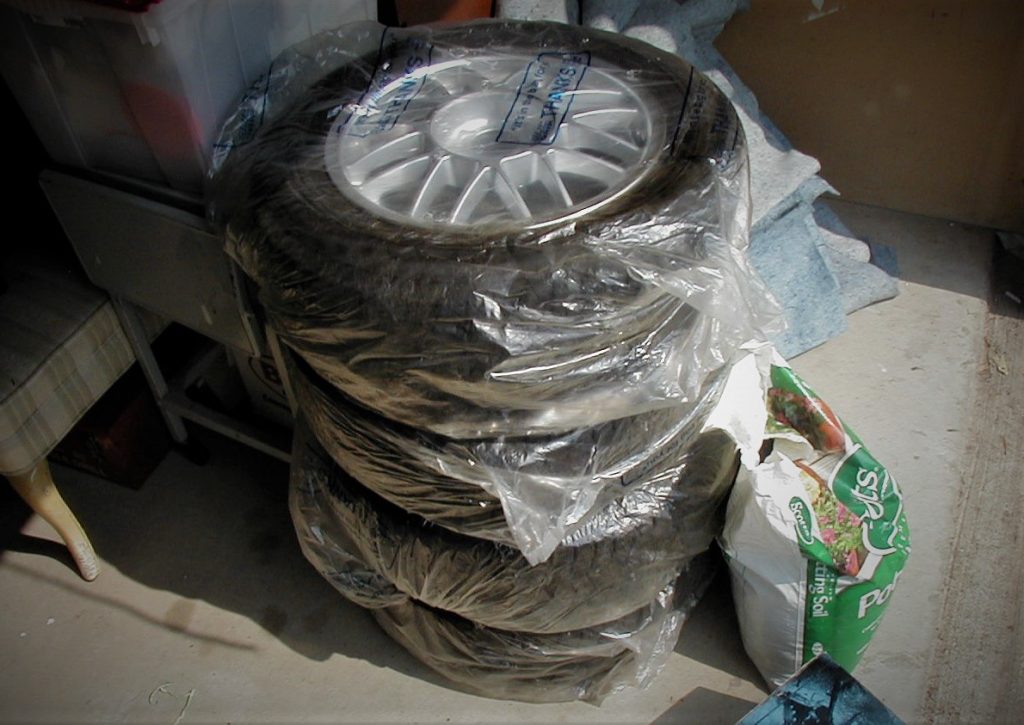
When it comes to storing your tires, there are a handful of variables. The fine folks over at Michelin have some in-depth guidance on the topic, but here’s a good summary.
First off, we’re assuming your seasonal tires will remain mounted on the wheels here, as unmounted tires have different storage demands.
Michelin recommends storing mounted tires by either laying them on their sides in a vertical stack, as pictured above or, if possible, hung vertically on wall-mounted hooks, like this:
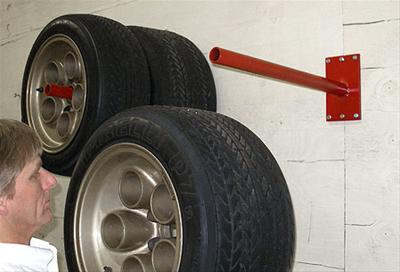
For unmounted tires, you can store them sitting vertically, side by side, in one of those wall-mounted wheel and tire storage racks.
The big thing to remember is to store them in a well ventilated, cool, and dry place—indoors if possible. Excess moisture can degrade tire compounds. Cover or wrap the tires, particularly if they’re stored outdoors, but make sure the bags are not completely sealed, as you want to let the tires “breathe” a bit to avoid moisture building inside. If the tires are exposed to sunlight, use dark, opaque bags (aka trash bags) to mitigate light degradation.
Stacking your tires on the ground? Put down some wood blocks to keep the tires off the floor to further prevent potential moisture ingress.
Finally, keep your tires away from any heat sources. Furnaces, boiler pipes, heck—even battery chargers, electric motors, and welders—anything that could potentially ignite the tire compound.
***
5. Peek Around to Inspect Your Chassis & Brakes
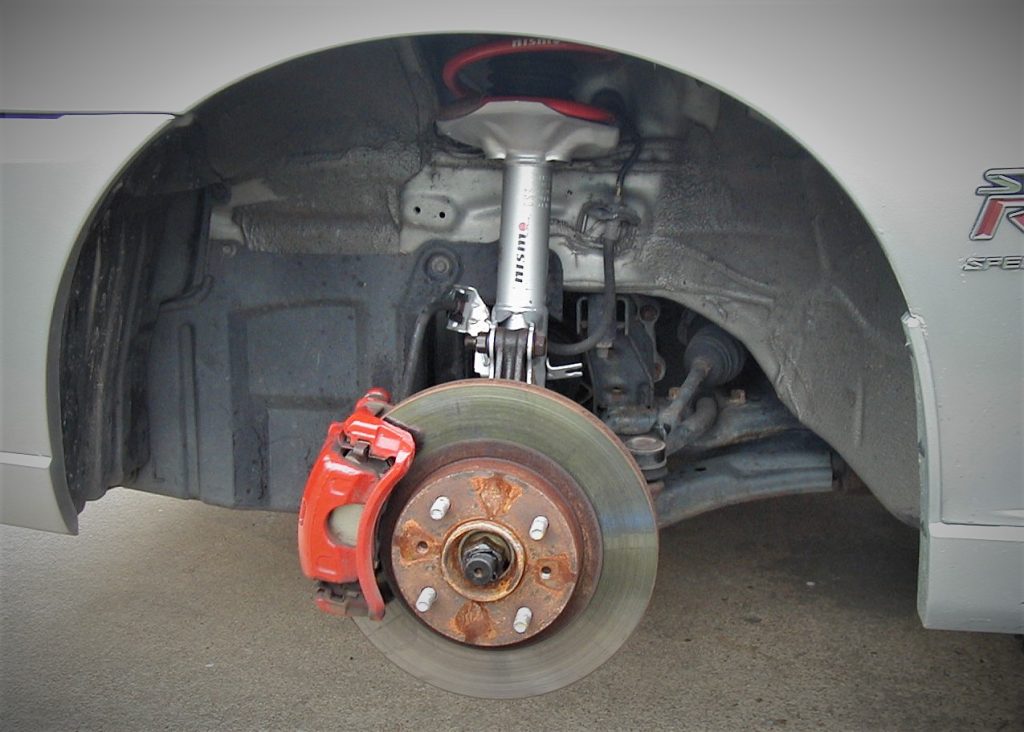
Your wheel well is an epicenter of vehicle engineering, where brakes, suspension, steering, and drivetrain all converge to make your car move the way you want it to. That also means, if something’s wrong, there’s a good chance it’ll happen in here.
So you’ve got plenty of good reasons to cram your head in the wheel well and take a look around. Look for leaks from, say, a brake fitting or CV joint. Check for rust forming in the fender lips and see if there are any signs of unusual rubbing or impacts. Replace any of those pesky plastic body fasteners that may have fallen out of your splash shields too.
And this routine is perhaps most important as you bolt your summer tires back on. If our experience is any indication, winter is where rust and wear problems are born.
Stopping a problem before it starts is the name of the game here, and if you’re doing seasonal wheel/tire changes, you automatically get two chances a year to do this.
***
Got any more tips or tire storage hacks to share with us? Let us hear about it in the comments section below—we’re all about learning new tricks here.
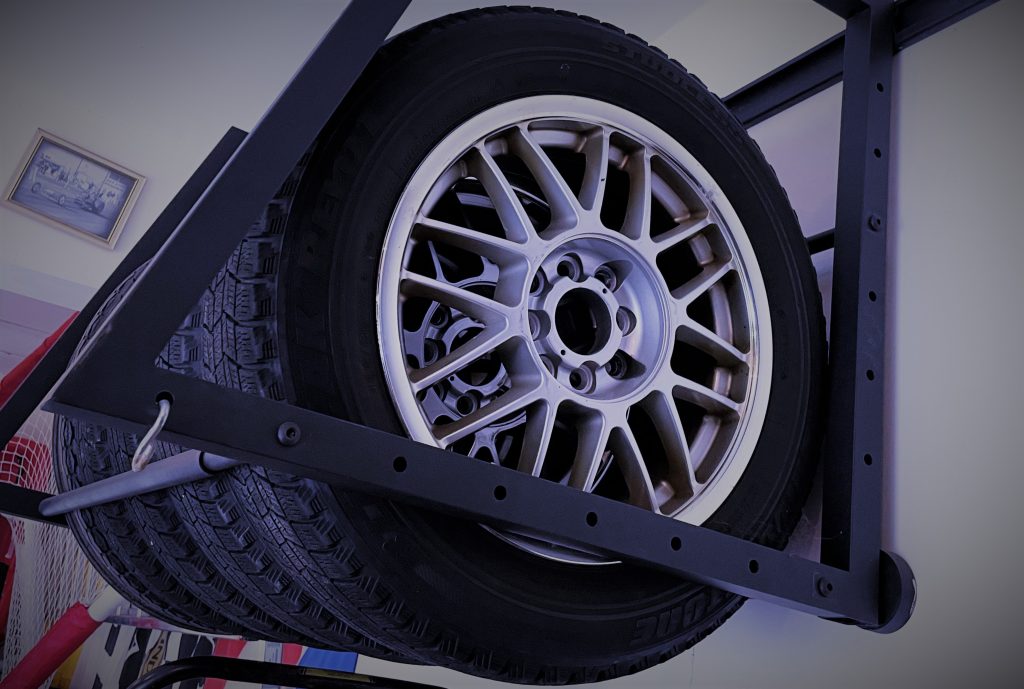

Comments